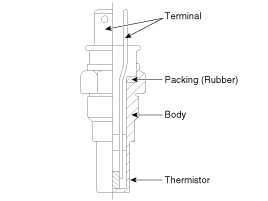 Kia Sedona: CVVT Oil Temperature Sensor (OTS) Description and Operation
Kia Sedona: CVVT Oil Temperature Sensor (OTS) Description and Operation
Third generation YP (2014-2025) / Kia Sedona YP Service Manual / Engine Control / Fuel System / Engine Control System / CVVT Oil Temperature Sensor (OTS) Description and Operation
| Description |
Continuous Variable Valve Timing (CVVT) system advances or
retards the valve timing of the intake and exhaust valve in accordance
with the ECM control signal which is calculated by the engine speed and
load.
By controlling CVVT, the valve over-lap or under-lap occurs,
which makes better fuel economy, reduces exhaust gases (NOx, HC) and
improves engine performance through reduction of pumping loss, internal
EGR effect, improvement of combustion stability, improvement of
volumetric efficiency, and increase of expansion work.
This system consists of:
- the CVVT Oil Control Valve (OCV) which supplies the engine
oil to the cam phaser or cuts the engine oil from the cam phaser in
accordance with the ECM PWM (Pulse With Modulation) control signal,
- the CVVT Oil Temperature Sensor (OTS) which measures the engine oil temperature,
- and the Cam Phaser which varies the cam phase by using the hydraulic force of the engine oil.
The engine oil released from the CVVT oil control valve
varies the cam phase in the direction (Intake Advance/Exhaust Retard) or
opposite direction (Intake Retard/Exhaust Advance) of the engine
rotation by rotating the rotor connected with the camshaft inside the
cam phaser.

 CVVT Oil Temperature Sensor (OTS) Specifications
CVVT Oil Temperature Sensor (OTS) Specifications
Specification
TemperatureResistance (kΩ)Output Voltage (V) [Ref=5V]°C°F-40-4052.154.82-20-416.524.38 ~ 4.530326.03.7520682.452.60 ~ 2.91401041.111.78601400.541.06801760.290.58 ~ 0.691002120.1 ...
 CVVT Oil Temperature Sensor (OTS) Schematic Diagrams
CVVT Oil Temperature Sensor (OTS) Schematic Diagrams
Circuit Diagram
...
Other Information:
Tail Gate Lift Repair procedures
Replacement
Take care to not let the tailgate fall on you as the lifts
are removed. Have a helper hold the tailgate open, or use a secure
method to hold it open.
...
Comfort mode
The steering wheel becomes lighter. The comfort mode is usually used when driving
in the city or when parking the vehicle.
For your safety, if you press the steering mode button while operatin ...
Categories
- Home
- First Generation
- Second Generation
- Third generation
- Kia Sedona YP 2014-2025 Owners Manual
- Kia Sedona YP 2014-2025 Service Manual
Copyright © www.kisedona.com 2016-2025
